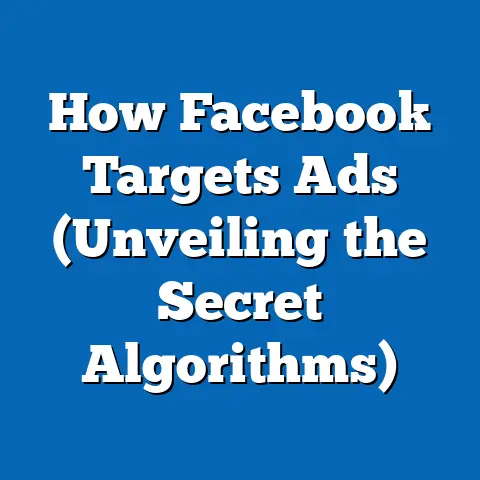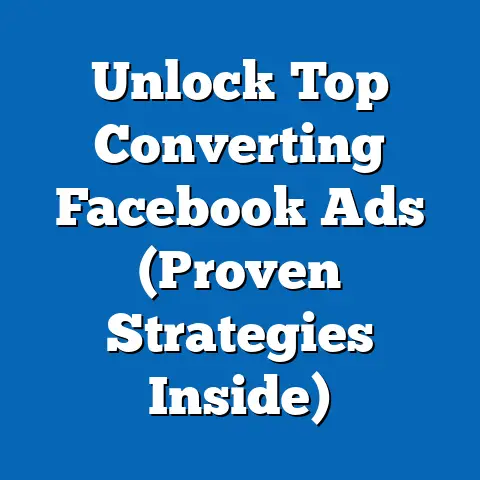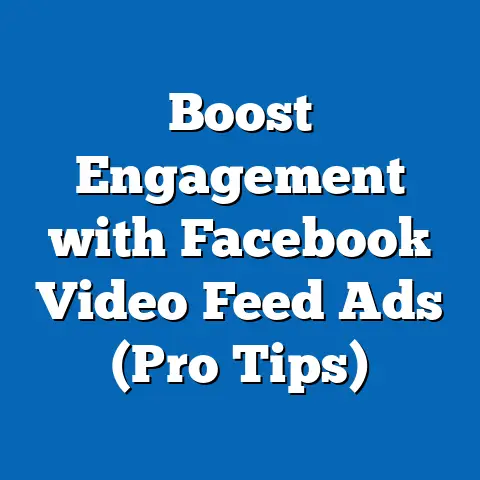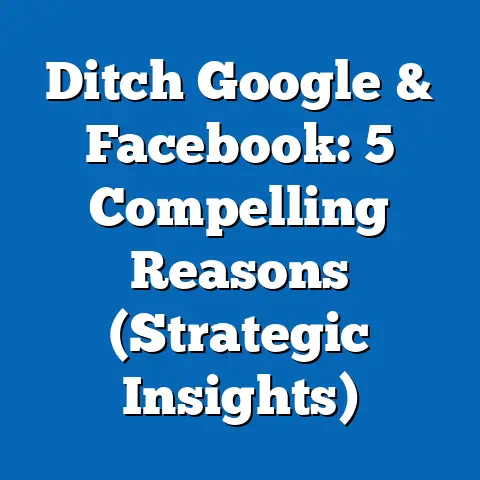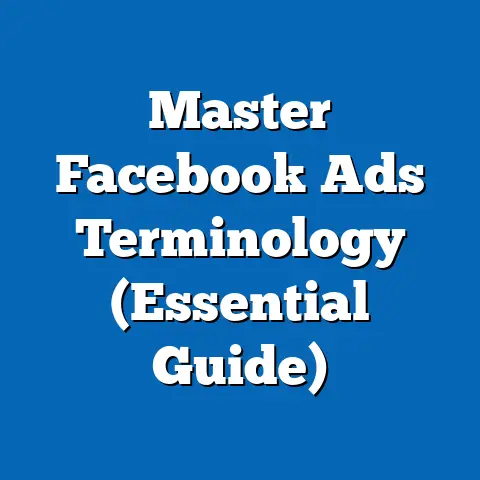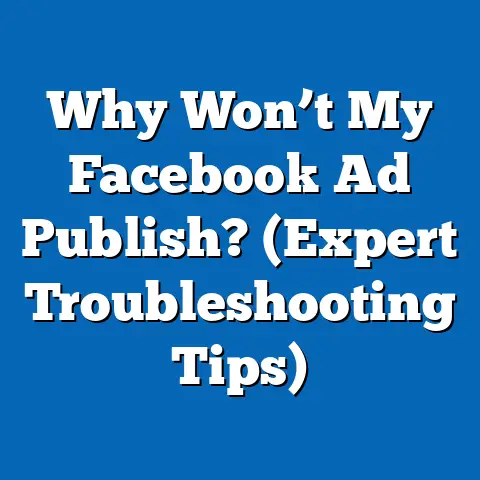Master Facebook Ads to Skyrocket Business (Pro Insights)
Master Facebook Ads to Skyrocket Business: Pro Insights
Imagine walking through a bustling marketplace. The air is thick with the aromas of exotic spices, the vibrant colors of handcrafted goods catch your eye, and the sounds of bartering fill your ears. Each stall offers a unique texture, a distinct experience. Facebook Ads is much the same – a digital marketplace teeming with opportunities, where your ads are the textures that attract and engage potential customers. Mastering this platform is no longer an option; it’s a necessity for any business looking to thrive in today’s digital age.
In this guide, I’ll walk you through the intricate details of Facebook advertising, from understanding the ecosystem to crafting compelling creatives, targeting the right audiences, and optimizing your budget. I’ll also share some advanced strategies I’ve learned over the years, along with my personal experiences, to help you achieve success.
1. Understanding the Facebook Ads Ecosystem
Facebook Ads is more than just placing an image and some text on a user’s feed. It’s a sophisticated system that leverages data, algorithms, and creative execution to connect businesses with their ideal customers. It sits at the heart of digital marketing, offering unparalleled reach and targeting capabilities that traditional advertising methods can only dream of.
Defining Facebook Ads:
Facebook Ads are paid advertisements that appear on Facebook, Instagram, Messenger, and the Audience Network (a collection of websites and apps). These ads are designed to reach specific audiences based on demographics, interests, behaviors, and more. This precision targeting is what sets Facebook Ads apart.
The Various Formats:
Facebook offers a variety of ad formats, each with its own unique “texture” of engagement:
- Image Ads: Simple yet effective, ideal for showcasing products or services with a single, compelling visual. Think of these as the classic, straightforward stall in the marketplace, offering a clear and concise message.
- Video Ads: Captivating and immersive, perfect for telling stories and demonstrating product features. I’ve found that short, attention-grabbing videos often outperform longer ones. These are like the street performers in the marketplace, drawing crowds with their dynamic displays.
- Carousel Ads: Allow you to showcase multiple images or videos in a single ad, each with its own headline, description, and link. Great for highlighting a range of products or features. These are the multi-tiered displays showcasing variety and options.
- Slideshow Ads: Similar to video ads but created from static images, offering a cost-effective way to create engaging content. These are the carefully curated displays, presenting a story through a series of images.
- Collection Ads: Designed for e-commerce, these ads allow users to browse and purchase products directly from the ad. These are the expansive storefronts within the marketplace, inviting customers to explore and buy.
The Reach of Facebook Ads:
With billions of active users, Facebook offers an unparalleled opportunity to reach a massive audience. According to recent statistics, Facebook boasts over 2.9 billion monthly active users, making it the most popular social media platform in the world. This vast reach, coupled with sophisticated targeting, makes Facebook Ads a powerful tool for businesses of all sizes.
The Facebook Ads Manager:
Takeaway: Understanding the Facebook Ads ecosystem is the first step to mastering this powerful platform. Explore the various ad formats, familiarize yourself with the Ads Manager, and recognize the immense potential reach that Facebook offers.
2. Crafting Compelling Ad Creatives
Your ad creative is the first thing people see, and it needs to grab their attention instantly. Think of it as the visual and verbal invitation to your booth in the marketplace. If it’s dull and uninspired, people will simply walk on by.
The Elements of Effective Ad Creatives:
- Visuals: High-quality images and videos are essential. Use visuals that are relevant to your target audience and that evoke emotion. I’ve found that images with people in them tend to perform better than those without.
- Headlines: Your headline is the first piece of text people will read, so make it count. It should be clear, concise, and attention-grabbing. Use strong verbs and highlight the benefits of your product or service.
- Calls-to-Action (CTAs): Tell people what you want them to do. Use clear and compelling CTAs such as “Shop Now,” “Learn More,” or “Get Started.” The CTA should be prominently displayed and easy to click.
The “Textures” of Visuals:
The visual “textures” you use in your ads can significantly impact their performance. Consider these elements:
- Color: Use colors that are consistent with your brand and that evoke the desired emotion. For example, blue is often associated with trust and reliability, while red is associated with excitement and energy.
- Typography: Choose fonts that are easy to read and that align with your brand’s personality. Bold typography can be used to highlight key messages.
- Imagery: Use high-quality images that are relevant to your target audience. Consider using images of people using your product or service.
Examples of Successful Ad Creatives:
I’ve seen countless ads over the years, but some stand out as particularly effective. Here’s an example:
- A clothing brand: Uses a high-quality image of a model wearing their latest collection, showcasing the clothing in a real-world setting. The headline is concise and attention-grabbing, highlighting the brand’s unique selling proposition. The CTA is clear and compelling, inviting users to “Shop Now.”
What makes this ad effective?
- Visual Appeal: The image is visually appealing and relevant to the target audience.
- Clear Messaging: The headline is concise and highlights the brand’s unique selling proposition.
- Compelling CTA: The CTA is clear and invites users to take action.
A/B Testing:
A/B testing is a crucial part of optimizing your ad creatives. It involves testing different versions of your ad to see which performs best. Test different visuals, headlines, CTAs, and targeting options. Over time, you’ll learn what resonates with your audience.
Takeaway: Crafting compelling ad creatives is essential for driving clicks and conversions. Use high-quality visuals, write clear and concise headlines, and include compelling CTAs. Don’t be afraid to experiment with different textures and A/B test your ads to see what works best.
3. Targeting the Right Audience
Reaching the right audience is crucial for the success of your Facebook Ads campaigns. It’s like knowing exactly who to invite to your marketplace booth – you don’t want to waste your time and resources on people who aren’t interested in what you have to offer.
The Significance of Audience Targeting:
Targeting allows you to show your ads to people who are most likely to be interested in your product or service. This increases the likelihood of clicks, conversions, and ultimately, ROI.
Targeting Options:
Facebook offers a wide range of targeting options:
- Demographics: Target people based on age, gender, location, education, job title, and more.
- Interests: Target people based on their interests, hobbies, and passions.
- Behaviors: Target people based on their online behavior, such as purchase history, device usage, and travel habits.
- Custom Audiences: Upload your own customer data to create custom audiences. This is great for retargeting existing customers or reaching people who are similar to your best customers.
- Lookalike Audiences: Create audiences that are similar to your existing customers. This is a great way to expand your reach and find new customers who are likely to be interested in your product or service.
Creating Buyer Personas:
A buyer persona is a semi-fictional representation of your ideal customer. It’s based on research and data about your existing customers and potential customers. Creating buyer personas helps you understand your audience’s needs, motivations, and behaviors.
When creating buyer personas, consider these factors:
- Demographics: Age, gender, location, education, job title, income.
- Interests: Hobbies, passions, favorite brands, online activities.
- Behaviors: Purchase history, device usage, social media habits.
- Pain Points: What are their biggest challenges and frustrations?
- Goals: What are they trying to achieve?
Facebook Pixel for Retargeting:
The Facebook Pixel is a small piece of code that you place on your website. It allows you to track the actions that people take on your website after clicking on your ad. This data can be used to retarget people who have visited your website but haven’t yet made a purchase.
Retargeting is a powerful way to increase conversions. It allows you to show ads to people who have already expressed interest in your product or service.
Takeaway: Targeting the right audience is essential for the success of your Facebook Ads campaigns. Use the various targeting options available to reach people who are most likely to be interested in your product or service. Create buyer personas to understand your audience’s needs and motivations. Use the Facebook Pixel to retarget people who have visited your website.
4. Budgeting and Bidding Strategies
Managing your budget and bidding effectively is crucial for maximizing your ROI on Facebook Ads. It’s like carefully allocating your resources to ensure you get the most out of your marketplace booth – you want to attract the right customers without overspending.
Budgeting Options:
Facebook offers two main budgeting options:
- Daily Budget: Sets the average amount you’re willing to spend each day.
- Lifetime Budget: Sets the total amount you’re willing to spend over the entire duration of your campaign.
The best option for you depends on your goals and your level of experience. I typically recommend starting with a daily budget, as it gives you more control and flexibility.
Bidding Strategies:
Facebook offers a variety of bidding strategies:
- Cost Per Click (CPC): You pay each time someone clicks on your ad.
- Cost Per Impression (CPM): You pay each time your ad is shown to someone.
- Cost Per Action (CPA): You pay each time someone takes a specific action, such as making a purchase or filling out a form.
The best bidding strategy for you depends on your goals and your budget. If you’re focused on driving traffic to your website, CPC might be the best option. If you’re focused on brand awareness, CPM might be a better choice.
Optimizing ROI:
To optimize your ROI, you need to track your performance metrics and make adjustments to your budget and bidding strategies accordingly.
Here are some tips for optimizing your ROI:
- Track Your Performance Metrics: Monitor your click-through rate, conversion rate, and return on ad spend.
- A/B Test Your Ads: Test different visuals, headlines, CTAs, and targeting options to see what works best.
- Adjust Your Budget: If you’re seeing a good return on investment, consider increasing your budget. If you’re not seeing the results you want, consider decreasing your budget or adjusting your bidding strategy.
- Refine Your Targeting: Make sure you’re targeting the right audience. If you’re not, you’re wasting your money.
Takeaway: Managing your budget and bidding effectively is crucial for maximizing your ROI on Facebook Ads. Choose the right budgeting option and bidding strategy for your goals. Track your performance metrics and make adjustments accordingly.
5. Analyzing Performance Metrics
Analyzing your performance metrics is essential for understanding the effectiveness of your Facebook Ads campaigns. It’s like checking the pulse of your marketplace booth – you need to know how many people are visiting, what they’re buying, and whether they’re enjoying the experience.
Key Performance Metrics:
- Click-Through Rate (CTR): The percentage of people who see your ad and click on it. A high CTR indicates that your ad is relevant and engaging.
- Conversion Rate: The percentage of people who click on your ad and complete a desired action, such as making a purchase or filling out a form. A high conversion rate indicates that your landing page is effective and that your offer is compelling.
- Return on Ad Spend (ROAS): The amount of revenue you generate for every dollar you spend on advertising. A high ROAS indicates that your campaigns are profitable.
- Cost Per Acquisition (CPA): The average cost of acquiring a new customer through your advertising campaigns. A low CPA indicates that your campaigns are efficient.
Interpreting Metrics:
Interpreting your performance metrics can be challenging, but it’s essential for understanding the effectiveness of your campaigns.
Here are some tips for interpreting your metrics:
- Compare Your Metrics to Industry Benchmarks: See how your metrics stack up against industry averages. This will give you a sense of whether your campaigns are performing well or not.
- Track Your Metrics Over Time: Monitor your metrics over time to see how they’re trending. This will help you identify areas for improvement.
- Segment Your Data: Segment your data to see how different demographics, interests, and behaviors are performing. This will help you refine your targeting and create more effective ads.
Ongoing Analysis and Iteration:
Analyzing your performance metrics is not a one-time task. It’s an ongoing process that requires continuous monitoring and iteration.
Here are some tips for ongoing analysis and iteration:
- Set Up Regular Reporting: Create a schedule for reviewing your performance metrics. This will help you stay on top of your campaigns and identify areas for improvement.
- Experiment with Different Strategies: Don’t be afraid to experiment with different visuals, headlines, CTAs, and targeting options.
- Stay Up-to-Date on the Latest Trends: The Facebook Ads landscape is constantly evolving. Stay up-to-date on the latest trends and best practices.
Takeaway: Analyzing your performance metrics is essential for understanding the effectiveness of your Facebook Ads campaigns. Track your metrics, interpret them, and iterate on your strategies accordingly.
6. Advanced Strategies for Success
Once you’ve mastered the basics of Facebook Ads, you can start exploring some advanced strategies to take your campaigns to the next level. These are the techniques that separate the seasoned marketers from the beginners, allowing you to truly dominate the Facebook advertising landscape.
Lookalike Audiences:
Lookalike audiences are a powerful way to expand your reach and find new customers who are likely to be interested in your product or service. They allow you to create audiences that are similar to your existing customers based on demographics, interests, and behaviors.
Dynamic Ads:
Dynamic ads are personalized ads that show products or services that people have already viewed on your website. They’re a great way to retarget people who have shown interest in your products or services but haven’t yet made a purchase.
Storytelling in Ads:
People are more likely to engage with ads that tell a story. Use your ads to tell a compelling story about your brand, your products, or your customers.
User-Generated Content:
User-generated content (UGC) is content that is created by your customers, such as reviews, testimonials, and photos. UGC can be a powerful way to build trust and credibility with potential customers.
Integrating Facebook Ads with Other Marketing Channels:
Facebook Ads can be even more effective when integrated with other marketing channels, such as email, content marketing, and social media.
Takeaway: Explore advanced strategies such as lookalike audiences, dynamic ads, storytelling, user-generated content, and integration with other marketing channels to take your Facebook Ads campaigns to the next level.
Conclusion: The Future of Facebook Ads
The world of Facebook Ads is constantly evolving. What works today may not work tomorrow. That’s why it’s essential to stay up-to-date on the latest trends and best practices.
The future of Facebook Ads is likely to be more personalized, more data-driven, and more integrated with other marketing channels. Businesses that embrace these trends and adapt their strategies accordingly will be the ones that succeed.
I’ve seen firsthand how mastering Facebook Ads can transform a business. It’s not just about reaching your goals; it’s about creating memorable experiences that resonate with your audience. So, embrace the textures of innovation, keep learning, and keep adapting. The potential is limitless.
My journey with Facebook Ads has been filled with both successes and failures. But each experience has taught me valuable lessons that I’ve shared with you in this guide. I hope this information empowers you to navigate the Facebook advertising landscape with confidence and achieve your business goals. Good luck, and happy advertising!

